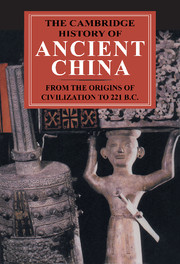Book contents
- Frontmatter
- Introduction
- 1 China on the Eve of the Historical Period
- 2 Language and Writing
- 3 Shang Archaeology
- 4 The Shang: China’s First Historical Dynasty
- 5 Western Zhou History
- 6 Western Zhou Archaeology
- 7 The Waning of the Bronze Age: Material Culture and Social Developments, 770–481 B.C.
- 8 The Spring and Autumn Period
- 9 Warring States Political History
- 10 The Art and Architecture of the Warring States Period
- 11 The Classical Philosophical Writings
- 12 Warring States Natural Philosophy and Occult Thought
- 13 The Northern Frontier in Pre–Imperial China
- 14 The Heritage Left to the Empires
- Bibliography
- Index
- Map 1 Topography of China
- Map 3.1 Archaeological sites of the Early Bronze Age
- Map 6.1 Archaeological sites of the Western Zhou period
- References
9 - Warring States Political History
Published online by Cambridge University Press: 28 March 2008
- Frontmatter
- Introduction
- 1 China on the Eve of the Historical Period
- 2 Language and Writing
- 3 Shang Archaeology
- 4 The Shang: China’s First Historical Dynasty
- 5 Western Zhou History
- 6 Western Zhou Archaeology
- 7 The Waning of the Bronze Age: Material Culture and Social Developments, 770–481 B.C.
- 8 The Spring and Autumn Period
- 9 Warring States Political History
- 10 The Art and Architecture of the Warring States Period
- 11 The Classical Philosophical Writings
- 12 Warring States Natural Philosophy and Occult Thought
- 13 The Northern Frontier in Pre–Imperial China
- 14 The Heritage Left to the Empires
- Bibliography
- Index
- Map 1 Topography of China
- Map 3.1 Archaeological sites of the Early Bronze Age
- Map 6.1 Archaeological sites of the Western Zhou period
- References
Summary
The two and a half centuries commonly known as the age of the Warring States (481–221 B.C.) witnessed the creation of the major political institutions that defined early imperial China. The old league of cities ruled by the Zhou nobility was replaced by a system of territorial states built around unchallenged monarchs who commanded a large number of dependent officials. These in turn were employed to register and mobilize the individual peasant households, primarily for the sake of imposing universal military service. The mass peasant armies of the period entailed the emergence of military specialists who were masters of the theories and techniques of warfare. At the same time, the needs of diplomatic maneuver produced theorists of stratagem and persuasion who formulated new models of interstate relations. The Zhou world was also reinvented as a geographic entity, both through expansion to the south and the southwest and through new patterns of physical mobility that marked differences of status.
However, the writings of this period present no tidy portrait of politics or institutions. Since written materials were still rare, difficult to produce, and not widely diffused, “books” tended to emerge, evolve, and survive as the legacy of groups who defined themselves through loyalty to a common master. Members of these groups sought patrons who took an interest in the wisdom or expertise that they claimed to offer. As a consequence, the writings that preserve information about the political history of the period are pragmatic and factional. They are devoted to the policies, philosophies, and actions of those who actively participated in creating the new states, and they defend these actions or philosophies as uniquely efficacious.
- Type
- Chapter
- Information
- The Cambridge History of Ancient ChinaFrom the Origins of Civilization to 221 BC, pp. 587 - 650Publisher: Cambridge University PressPrint publication year: 1999
References
- 69
- Cited by

